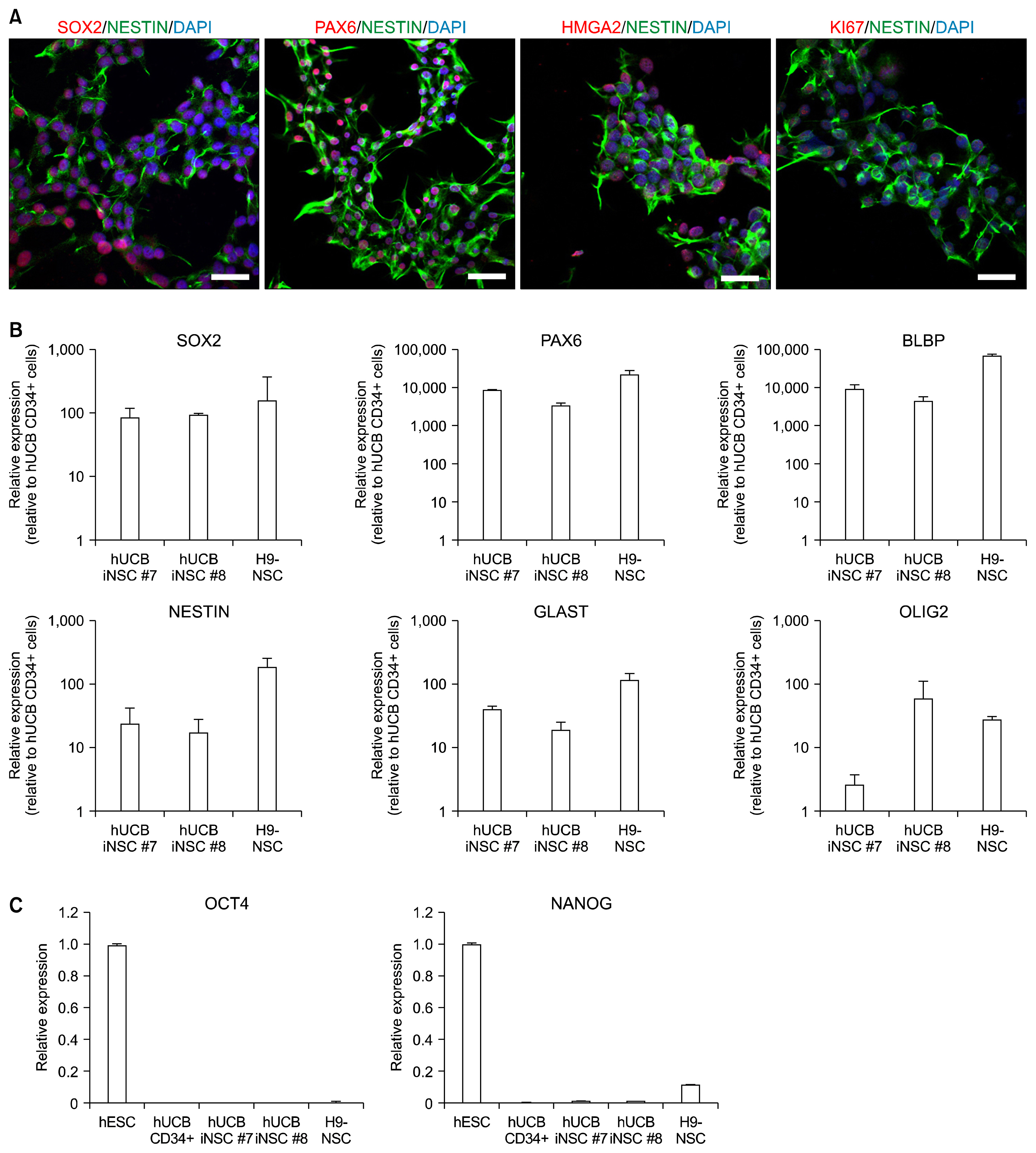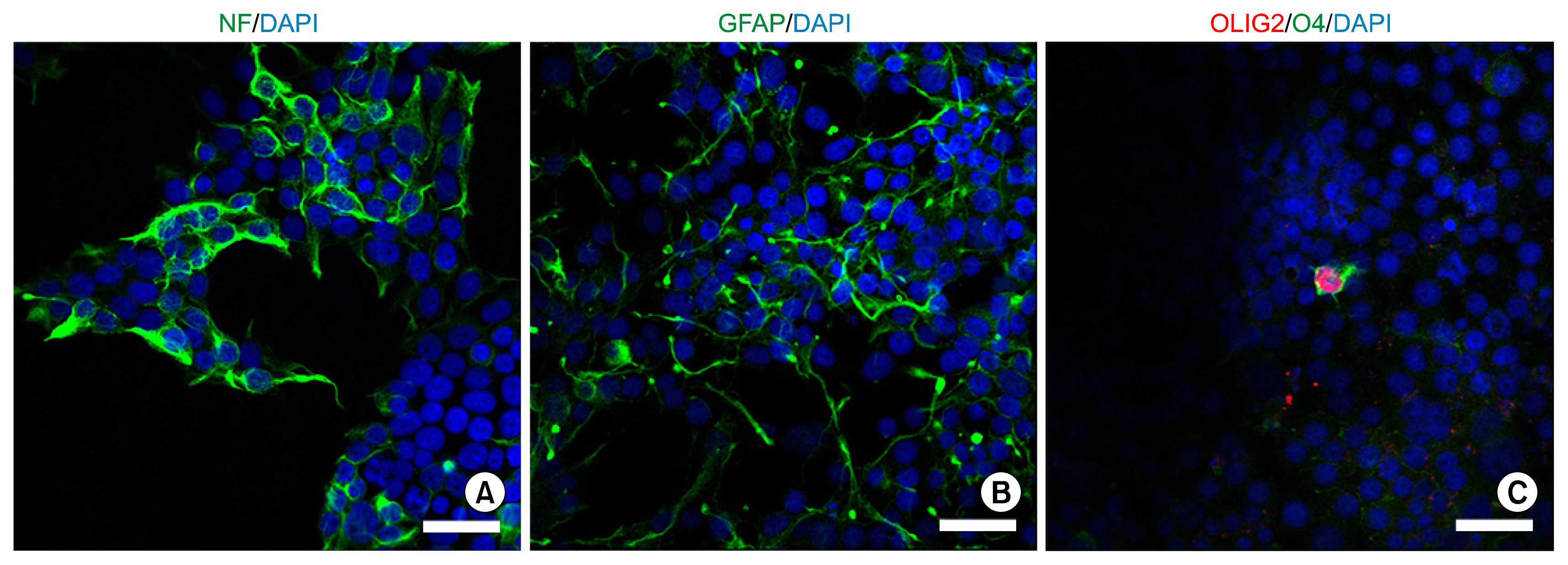Int J Stem Cells.
2017 Nov;10(2):227-234. 10.15283/ijsc17025.
Direct Conversion of Human Umbilical Cord Blood into Induced Neural Stem Cells with SOX2 and HMGA2
- Affiliations
-
- 1Adult Stem Cell Research Center, College of Veterinary Medicine, Seoul National University, Seoul, Korea. kangpub@snu.ac.kr
- 2The Research Institute for Veterinary Science, College of Veterinary Medicine, Seoul National University, Seoul, Korea.
- 3Hematology Branch, National Heart, Lung and Blood Institute, National Institutes of Health, Bethesda, USA.
- 4School of Medicine, Pusan National University, Busan, Korea.
- 5Biomedical Research Institute, Pusan National University Hospital, Busan, Korea.
- KMID: 2400876
- DOI: http://doi.org/10.15283/ijsc17025
Abstract
- Recent advances have shown the direct reprogramming of mouse and human fibroblasts into induced neural stem cells (iNSCs) without passing through an intermediate pluripotent state. Thus, direct reprogramming strategy possibly provides a safe and homogeneous cellular platform. However, the applications of iNSCs for regenerative medicine are limited by the restricted availability of cell sources. Human umbilical cord blood (hUCB) cells hold great potential in that immunotyped hUCB units can be immediately obtained from public banks. Moreover, hUCB samples do not require invasive procedures during collection or an extensive culture period prior to reprogramming. We recently reported that somatic cells can be directly converted into iNSCs with high efficiency and a short turnaround time. Here, we describe the detailed method for the generation of iNSCs derived from hUCB (hUCB iNSCs) using the lineage-specific transcription factors SOX2 and HMGA2. The protocol for deriving iNSC-like colonies takes 1~2 weeks and establishment of homogenous hUCB iNSCs takes additional 2 weeks. Established hUCB iNSCs are clonally expandable and multipotent producing neurons and glia. Our study provides an accessible method for generating hUCB iNSCs, contributing development of in vitro neuropathological model systems.
MeSH Terms
Figure
Reference
-
References
1. Xu J, Du Y, Deng H. Direct lineage reprogramming: strategies, mechanisms, and applications. Cell Stem Cell. 2015; 16:119–134. DOI: 10.1016/j.stem.2015.01.013. PMID: 25658369.
Article2. Vierbuchen T, Ostermeier A, Pang ZP, Kokubu Y, Südhof TC, Wernig M. Direct conversion of fibroblasts to functional neurons by defined factors. Nature. 2010; 463:1035–1041. DOI: 10.1038/nature08797. PMID: 20107439. PMCID: 2829121.
Article3. Huang P, He Z, Ji S, Sun H, Xiang D, Liu C, Hu Y, Wang X, Hui L. Induction of functional hepatocyte-like cells from mouse fibroblasts by defined factors. Nature. 2011; 475:386–389. DOI: 10.1038/nature10116. PMID: 21562492.
Article4. Ieda M, Fu JD, Delgado-Olguin P, Vedantham V, Hayashi Y, Bruneau BG, Srivastava D. Direct reprogramming of fibroblasts into functional cardiomyocytes by defined factors. Cell. 2010; 142:375–386. DOI: 10.1016/j.cell.2010.07.002. PMID: 20691899. PMCID: 2919844.
Article5. Yu B, He ZY, You P, Han QW, Xiang D, Chen F, Wang MJ, Liu CC, Lin XW, Borjigin U, Zi XY, Li JX, Zhu HY, Li WL, Han CS, Wangensteen KJ, Shi Y, Hui LJ, Wang X, Hu YP. Reprogramming fibroblasts into bipotential hepatic stem cells by defined factors. Cell Stem Cell. 2013; 13:328–340. DOI: 10.1016/j.stem.2013.06.017. PMID: 23871605.
Article6. Riddell J, Gazit R, Garrison BS, Guo G, Saadatpour A, Mandal PK, Ebina W, Volchkov P, Yuan GC, Orkin SH, Rossi DJ. Reprogramming committed murine blood cells to induced hematopoietic stem cells with defined factors. Cell. 2014; 157:549–564. DOI: 10.1016/j.cell.2014.04.006. PMID: 24766805. PMCID: 4060823.
Article7. Yang N, Zuchero JB, Ahlenius H, Marro S, Ng YH, Vierbuchen T, Hawkins JS, Geissler R, Barres BA, Wernig M. Generation of oligodendroglial cells by direct lineage conversion. Nat Biotechnol. 2013; 31:434–439. DOI: 10.1038/nbt.2564. PMID: 23584610. PMCID: 3677690.
Article8. Sheng C, Zheng Q, Wu J, Xu Z, Wang L, Li W, Zhang H, Zhao XY, Liu L, Wang Z, Guo C, Wu HJ, Liu Z, Wang L, He S, Wang XJ, Chen Z, Zhou Q. Direct reprogramming of Sertoli cells into multipotent neural stem cells by defined factors. Cell Res. 2012; 22:208–218. DOI: 10.1038/cr.2011.175. PMCID: 3351918.
Article9. Thier M, Wörsdörfer P, Lakes YB, Gorris R, Herms S, Opitz T, Seiferling D, Quandel T, Hoffmann P, Nöthen MM, Brüstle O, Edenhofer F. Direct conversion of fibroblasts into stably expandable neural stem cells. Cell Stem Cell. 2012; 10:473–479. DOI: 10.1016/j.stem.2012.03.003. PMID: 22445518.
Article10. Ring KL, Tong LM, Balestra ME, Javier R, Andrews-Zwilling Y, Li G, Walker D, Zhang WR, Kreitzer AC, Huang Y. Direct reprogramming of mouse and human fibroblasts into multipotent neural stem cells with a single factor. Cell Stem Cell. 2012; 11:100–109. DOI: 10.1016/j.stem.2012.05.018. PMID: 22683203. PMCID: 3399516.
Article11. Giorgetti A, Montserrat N, Aasen T, Gonzalez F, Rodríguez-Pizà I, Vassena R, Raya A, Boué S, Barrero MJ, Corbella BA, Torrabadella M, Veiga A, Izpisua Belmonte JC. Generation of induced pluripotent stem cells from human cord blood using OCT4 and SOX2. Cell Stem Cell. 2009; 5:353–357. DOI: 10.1016/j.stem.2009.09.008. PMID: 19796614. PMCID: 2779776.
Article12. Ballen KK, Gluckman E, Broxmeyer HE. Umbilical cord blood transplantation: the first 25 years and beyond. Blood. 2013; 122:491–498. DOI: 10.1182/blood-2013-02-453175. PMID: 23673863. PMCID: 3952633.
Article13. Lee JH, Mitchell RR, McNicol JD, Shapovalova Z, Laronde S, Tanasijevic B, Milsom C, Casado F, Fiebig-Comyn A, Collins TJ, Singh KK, Bhatia M. Single transcription factor conversion of human blood fate to NPCs with CNS and PNS developmental capacity. Cell Rep. 2015; 11:1367–1376. DOI: 10.1016/j.celrep.2015.04.056. PMID: 26004181.
Article14. Yu KR, Shin JH, Kim JJ, Koog MG, Lee JY, Choi SW, Kim HS, Seo Y, Lee S, Shin TH, Jee MK, Kim DW, Jung SJ, Shin S, Han DW, Kang KS. Rapid and Efficient Direct Conversion of Human Adult Somatic Cells into Neural Stem Cells by HMGA2/let-7b. Cell Rep. 2015; 10:441–452. DOI: 10.1016/j.celrep.2014.12.038.
Article15. Zhu S, Wang H, Ding S. Reprogramming fibroblasts toward cardiomyocytes, neural stem cells and hepatocytes by cell activation and signaling-directed lineage conversion. Nat Protoc. 2015; 10:959–973. DOI: 10.1038/nprot.2015.059. PMID: 26042385.
Article16. Bar-Nur O, Verheul C, Sommer AG, Brumbaugh J, Schwarz BA, Lipchina I, Huebner AJ, Mostoslavsky G, Hochedlinger K. Lineage conversion induced by pluripotency factors involves transient passage through an iPSC stage. Nat Biotechnol. 2015; 33:761–768. DOI: 10.1038/nbt.3247. PMID: 26098450. PMCID: 4840929.
Article17. Weissbein U, Ben-David U, Benvenisty N. Virtual karyotyping reveals greater chromosomal stability in neural cells derived by transdifferentiation than those from stem cells. Cell Stem Cell. 2014; 15:687–691. DOI: 10.1016/j.stem.2014.10.018. PMID: 25479746.
Article18. Lujan E, Chanda S, Ahlenius H, Südhof TC, Wernig M. Direct conversion of mouse fibroblasts to self-renewing, tripotent neural precursor cells. Proc Natl Acad Sci U S A. 2012; 109:2527–2532. DOI: 10.1073/pnas.1121003109. PMID: 22308465. PMCID: 3289376.
Article19. Kim D, Kim CH, Moon JI, Chung YG, Chang MY, Han BS, Ko S, Yang E, Cha KY, Lanza R, Kim KS. Generation of human induced pluripotent stem cells by direct delivery of reprogramming proteins. Cell Stem Cell. 2009; 4:472–476. DOI: 10.1016/j.stem.2009.05.005. PMID: 19481515. PMCID: 2705327.
Article20. Mandal PK, Rossi DJ. Reprogramming human fibroblasts to pluripotency using modified mRNA. Nat Protoc. 2013; 8:568–582. DOI: 10.1038/nprot.2013.019. PMID: 23429718.
Article21. Zhang M, Lin YH, Sun YJ, Zhu S, Zheng J, Liu K, Cao N, Li K, Huang Y, Ding S. Pharmacological reprogramming of fibroblasts into neural stem cells by signaling-directed transcriptional activation. Cell Stem Cell. 2016; 18:653–667. DOI: 10.1016/j.stem.2016.03.020. PMID: 27133794. PMCID: 4864020.
Article
- Full Text Links
- Actions
-
Cited
- CITED
-
- Close
- Share
- Similar articles
-
- Robust and Reproducible Generation of Induced Neural Stem Cells from Human Somatic Cells by Defined Factors
- Stem Cell Transplantation in Umbilical Cord Blood(I) Expansion Effects of Stem Cells in Umbilical Cord Blood with Various Hematopoietic Growth Factors
- Differentiation of Osteoblast Progenitor Cells from Human Umbilical Cord Blood
- Differential Potential of Stem Cells Following Their Origin: Subacromial Bursa, Bone Marrow, Umbilical Cord Blood
- Umbilical Cord Blood Transplantation




